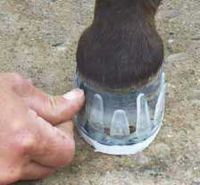Foot Disease (Geriatric) - Donkey

Chronic foot disease is the most common veterinary condition seen in the geriatric donkey and is a reflection on the poor foot management, pasture lifestyle and levels of obesity within the UK donkey population.
High rates of acute and chronic laminitis, untreated foot infections and conditions affecting the white line, poor husbandry and neglected foot care regimes are all reflected in the alarmingly high rates of chronic foot problems within the aged donkey population. As the animal ages, the chronic changes brought about by damage to joints, hoof capsule and weight-bearing surfaces can cause significant pain and discomfort and certainly have an effect on the quality of life of the ageing donkey.
However, at this point another word of warning must be expressed: when assessing the feet of an aged individual, it is important to weigh up clinical presentation against the radiographic evidence. It is often the case that pasture-sound individuals can show significant hoof capsule and radiographic changes when presented with an acute attack of lameness. Lesions on X-ray that would normally hold an extremely poor prognosis are in fact insignificant to this individual. Once the acute problem is remedied these animals will return to soundness despite the X-ray evidence to the contrary.
More frustratingly, however, the opposite can just as easily be true. That is, despite extensive diagnostic investigation, no obvious reason can be found for a severe case of foot lameness. Some of these animals have been known to return to soundness whilst others have been euthanased on grounds of quality of life.
Most commonly, elderly animals with a history of chronic laminitis show ‘text book’ signs and the consequential changes within the hoof capsule that this disease indicates. Conditions including changes to the hoof-pastern axis, pedal bone rotation and severe arthritis all warrant a high need for careful and regular assessment of the affected individual’s quality of life.
Animals which present with thin, sensitive soles and general discomfort in the foot (usually reflected in increased amounts of time lying down, slow tentative steps and weight shifting) may benefit from having plastic shoes fitted. As mentioned in Chapter 10, these stick-on shoes have been seen to significantly increase many affected animals’ quality of life although it should be noted that improvement is usually short term (mean 18 months). These shoes are contraindicated in animals prone to recurrent bouts of laminitis as they are almost impossible to remove when newly fitted should the feet require padding and support during a laminitic attack.
References
- Sprayson, T. (2008) The care of the geriatric donkey In Svendsen, E.D., Duncan, J. and Hadrill, D. (2008) The Professional Handbook of the Donkey, 4th edition, Whittet Books, Chapter 13
|
|
This section was sponsored and content provided by THE DONKEY SANCTUARY |
|---|